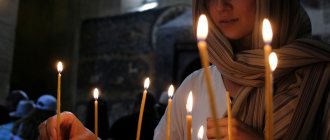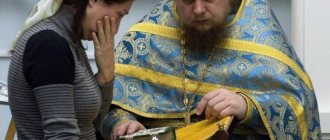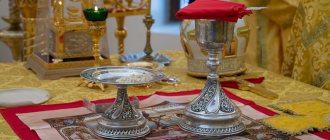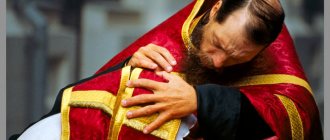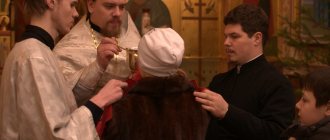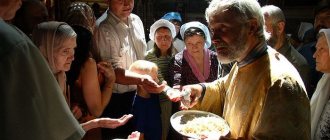Why is official marriage registration required before a wedding?
- Legal certificate. A civil marriage is an officially concluded marriage. Anything else is called cohabitation, in the church lexicon - fornication.
- Marriage is not celebrated in the Sacrament; in the Wedding, a legal marriage is filled with the grace of God for the creation of a family as a domestic church. Until 1917, marriage was concluded (registered) in the church. Therefore, the sequence should be normal: first the ticket, and only then the ballet.

- If someone believes that the “stamp in the passport” does not matter, then nothing prevents him from entering into a legal marriage and taking legal responsibility for his wife and future children. If he refuses to do this, then this means that this is an important obstacle for him, and not a trifle.
- 92% of women in adulterous cohabitation consider themselves married, and 85% of men in it consider themselves single!
- A man traditionally proposed marriage to a woman. First the hand - full responsibility and only then the heart - feelings.
How to take communion correctly
The sacrament of Communion comes after a minimum of 3 days of fasting, during which they fast and read special prayers. On the eve of communion, the newlyweds confess. Typically, clergy appoint communion on the wedding day. The communion procedure takes place on an empty stomach, therefore, starting from 12 at night, you cannot eat or drink.
In the morning, the newlyweds come to the service. Communion begins after reading the Lord's Prayer. You need to wait until the Royal Doors close, then, together with all the parishioners who want to receive communion, approach the altar.
After the priest brings out the Holy Gifts, reads two prayers, cross himself and go to the Chalice. To avoid accidentally touching the Chalice, keep your hands crossed on your chest, placing your right hand on top of your left. Approaching the Chalice, the communicant pronounces his name given at Baptism, opens his mouth wide, giving the priest the opportunity to put the Body and Blood of Christ into it. It is advisable to swallow them immediately. Then they kiss the edge of the Chalice and go to the table to take the prosphora and “warmth”.
They remain in the church until the end of the Divine Liturgy. Communion ends with the reading of prayers of thanksgiving in church or at home.
For the wedding it is necessary
- the bride and groom be church-going Christians (faithful);
- register the marriage in the registry office (first the marriage is concluded, and only then it is consecrated; it is impossible to consecrate something that does not yet exist);
- preliminary interview with a priest;
- a wedding pair of icons - the Savior and the Mother of God.
- wedding candles - sold in the Church Shop;
- towel (wedding towel) - plain: white (for laying under your feet). Long enough for two people to stand on;
- wedding rings. According to the Church Charter, rings must be made of different metals: the groom’s ring is gold, the bride’s ring is silver (it is advisable to observe this).
What to buy before the wedding
There is a whole list of items needed to perform the ritual.
- Wedding icons are an important attribute when blessing a couple. In the future, the Holy images of the Mother of God and Jesus Christ will become a talisman and blessing shrines for the family.
- Wedding rings have no edge or end. By putting the ring on each other, the bride and groom swear eternal love and the indissolubility of their consecrated marriage.
Gold rings are symbols of the sun's radiance, silver rings are a reflection of the moonlight, which shines in the reflection of the sun.
So the Orthodox family shines in the reflection of the love of God's Trinity.
- Candles for weddings.
- Handkerchiefs to hold candles and crowns.
- Embroidered towels or boards that: decorate icons;
- cover a tray with a loaf of bread;
- placed under your feet.
Wedding icon
Requirements for witnesses
- in pre-revolutionary Russia, a church marriage had legal force, so the wedding was necessarily performed with guarantors - popularly they were called groomsmen or best men, and in liturgical books - heirs; the guarantors confirmed with their signatures the wedding act in the registry; they, as a rule, knew the bride and groom well and vouched for them;
- currently, the presence of witnesses is not a mandatory, but desirable condition for the celebration of the Sacrament of Marriage; this is a tradition, not a canon: their presence is determined by the desire of the bride and groom;
- the modern role of witnesses is to spiritually support those entering into marriage with prayer and advice based on the experience of their godly Christian marriage;
- it is advisable to find witnesses who are Orthodox and God-loving, and therefore churchgoers;
- Divorced spouses or people living in a “civil” (not registered in the registry office) marriage cannot become guarantors for a wedding. The first, not retaining the grace they received in the Sacrament of Wedding and setting a bad example for the newlyweds, cannot be faithful mentors for the family being created. The latter, living in fornication, cannot begin the Church Sacraments at all until they stop their ungodly relationships.
Some features of the bride's clothing
- the bride must have a headdress covering her head (veil or scarf);
- shoulders must be covered (cape, scarf, veil);
- the dress is white. If people who have already been married for some time are getting married, or are getting remarried, then the bride is no longer required to wear a white dress;
- cosmetics - in minimal quantities.
- because If you also have to attend the Liturgy on the wedding day, then in total, in terms of time, it will take several hours. To keep you comfortable, consider wearing comfortable shoes.
Age of those getting married
- the lower age limit for performing the Sacrament of Wedding should be considered the onset of civil majority, when it is possible to conclude a marriage in the registry office;
- Church marriage law also sets the highest limit for marriage: for women - 60 years, for men - 70 years. This rule does not apply to those already married.
The Church does not sanctify a union between or with...
- Gentiles - representatives of non-Christian religions (for example, Muslims). A non-Christian cannot participate in an Orthodox sacrament, which is a wedding.
- unbaptized;
- atheists, even baptized ones;
- people who are related by blood and spirit;
- people whose officially confirmed mental illness deprives them of the opportunity to freely and consciously express their will.
- Orthodox Christians, with permission, can marry non-Orthodox Christians (Catholics, Protestants, Lutherans, Armenian Gregorians) provided that their children are baptized and raised in Orthodoxy. In special cases, an exception may be made for religiously mixed marriages. Only the ruling bishop can give a blessing for this;
- Consisting of: consanguinity (up to the fourth degree of relationship, for example, with a second cousin); in a spiritual relationship (if those wishing to marry are godparents of the same person or wish to marry a godson).
Sacrament of the Church - wedding
After the betrothal, with lit candles as a symbol of the Sacrament, the newlyweds move to the middle of the temple, following the priest. The priest offers incense to the Creator with the help of a censer, showing that in this way sincere fulfillment of the commandments of the Lord will be pleasing to the Creator.
The singers sing a psalm.
Psalm 127
Song of Ascension.
Blessed is everyone who fears the Lord and walks in His ways!
You will eat from the labor of your hands: blessed are you, and good to you!
Your wife is like a fruitful vine in your house; Your sons are like olive branches around your table:
so will the man who fears the Lord be blessed!
The Lord will bless you from Zion, and you will see the prosperity of Jerusalem all the days of your life;
You will see your sons' sons. Peace on Israel!
Between the lectern with the Gospel, cross and crowns laid out on it and the wedding couple, a cloth or towel is spread.
Before standing on the platform, the bride and groom once again confirm their decision to accept the wedding of their own free will, without any coercion. At the same time, emphasizing that none of them is bound by the promise of marriage with third parties.
The priest appeals to those present at the Sacrament to report facts that impede this union.
For in the future, all obstacles to marriage should be forgotten if they were not voiced before the blessing ceremony.
After this, the getting married couple stands on a towel laid under their feet. There is a sign that whoever stands on the board first will be the head of the house. Everyone present watches these actions with bated breath.
The priest speaks to the groom, asking whether, out of good will, sincere desire, he wants to marry the girl standing in front of him.
After a positive answer, the young man is obliged to confirm that he is not engaged to any other girl and is not bound by any promises to her.
The same questions are asked of the bride, clarifying whether she is going down the aisle under duress and is not promised to another man.
A mutually positive decision is not yet a union sanctified by God. For now, this decision may be the basis for concluding an official marriage in government bodies.
The sacrament of consecration of the new family before the Creator is performed over the officially registered newlyweds, the wedding ceremony begins, litanies are sounded, petitions for well-being, both spiritual and physical, for the newly born family.
Next, the priest reads three prayers.
The first prayer is filled with a request to Jesus Christ to bless the newlyweds with love for each other, long life, children and the purity of the marital bed. The priest asks for a blessing for the abundance in the house to be greater than the dew in the field, so that there will be everything in it, from grain to oil, allowing it to be shared with people in need.
“Bless this marriage: and give to Your servants a peaceful life, long life, love for each other in a union of peace, a long-lived seed, an unfading crown of glory; make them worthy to see the children of their children, keep their bed unblamed. And grant them from the dew of heaven from above, and from the fatness of the earth; Fill their houses with wheat, wine and oil, and every good thing, so that they share the excess with those in need, and grant to those who are now with us everything necessary for salvation.”
In the second prayer, an appeal to the Holy Trinity should be granted:
- children are like grains on an ear;
- abundance, like grapes on a vine;
- long life to see grandchildren.
“Give them the fruit of the womb, good children, like-mindedness in their souls, exalt them like the cedars of Lebanon, like a vine with beautiful branches, give them a spiked seed, so that, having contentment in everything, they may abound for every good deed that is pleasing to You. And may they see sons from their sons, like the young shoots of an olive tree, around their trunk, and having pleased You, may they shine like lights in the sky in You, our Lord.”
For the third time, a request is made to the Triune God to bless the young as heirs of Adam and Eve, created in the image and likeness of God, to create from them one spiritual flesh and to bless the womb of the wife, bestowing much fruit.
In reverence for the Great Creator, the union of a new couple in Heaven is sanctified and sealed by the Almighty himself.
The time has come for the main wedding ceremony - putting on the crown.
The priest takes the crown, baptizes the young man three times, giving him the image of Jesus Christ, located in front of the crown, to kiss and saying that the servant of God (name) is being married to the servant of God (name) in the Name of the Father, Son and Holy Spirit.
The same act is performed on the bride, only for the kissing she is offered to kiss the image of the Blessed Virgin Mary.
Wedding
Covered with the blessing of crowns, the couple awaits God's blessing as they stand before the face of the Almighty.
The most exciting and solemn moment of the entire Sacrament comes, when the priest, in the name of God, crowns the newlyweds, proclaiming blessings three times.
All those present must sincerely and reverently repeat the words of the priest within themselves, asking the Creator to bless the new family.
The priest seals God's blessing, proclaiming the birth of a new small church. Now it is a cell of a single Church, an indestructible church union. (Matthew 19:6)
At the conclusion of the wedding, the letter of the Apostle Paul to Christians in Ephesus is read, in which he says that a husband and wife are like Jesus and the Church. The husband is obliged to take care of his wife as if he were his own body; the wife’s task is to be submissive to her husband who loves her. (Eph. 5:20-33)
In his first letter to the Church of Corinth, the apostle left recommendations for the couple on behavior in the family to achieve complete harmony. (1 Cor.7:4).
The prayer “Our Father” is read, which the Savior left as a model of appeal to the Creator.
After this, the young couple drinks wine from a common cup, which brings joy, like the wedding at Cana, where Jesus turned water into wine.
The priest connects the right hands of the bride and groom with the help of an stole and covers it with his palm. This action symbolizes the transfer of the wife by the Church, uniting the couple in the name of Jesus Christ.
Taking the young people by the right hands, the priest walks around the lectern three times, performing troparia. Walking in a circle is a prophecy of eternal, never-ending earthly life for a new generation.
After removing the crowns and kissing the icons, the priest reads a few more prayers, after which the newlyweds kiss each other.
Behavior in the Temple during the Sacrament of Marriage
- The Sacrament of Wedding is not just a ritual, it is a prayer; treat with attention and reverence the prayers that are pronounced by the priest: during the entire Sacrament, the Church prays for almost no one else, just for the bride and groom (and one prayer “for the parents who raised them);
- everyone present at the wedding, to the best of their ability (with prayers, their words and thoughts), should pray for those two who are getting married;
- If possible, refrain from unnecessary conversations.
Tradition of parental blessing
- the groom and his parents come to the house of the bride’s parents and ask them for their daughter’s hand in marriage;
- upon consent to marriage, parents on both sides bless the newlyweds for a family union: the groom with the icon of Christ the Savior, the girl with the icon of the Most Holy Theotokos;
- the young make the sign of the cross and kiss the holy images;
- handing over icons, parents say that the time of raising children is over for them and with faith and hope they entrust their children to the all-powerful intercession of the Lord and Mother of God;
- icons, after the Wedding, are placed in the red corner, in the house where the bride and groom will live - these are the first icons of their family iconostasis.
- If one of the parents is not alive, then the survivor blesses;
- If parents are against marriage and do not want to give blessings, then you should contact your confessor and ask his advice on how valid the parents’ opinion is, is it based on selfishness or life experience and prudence.
The spiritual essence of a wedding
Jesus in the Bible said that people cannot destroy a union blessed by God. (Matthew 19:4-8).
The wedding ceremony in the Orthodox Church is an action performed by priests as intermediaries between God and people, during which two souls merge into one.
Genesis 1:27 says that God created man, notice, not two people, but one - the Lord created male and female.
The sacrament of a couple coming down the aisle consists of calling on the help of the Holy Trinity to give a blessing for their future family life.
During the blessing ceremony, the couple comes under the spiritual protection of the Church, becoming a part of It.
The head of the family is the husband, and to him is Jesus.
The married couple is a prototype of the relationship between Jesus and the Church, where Christ is the groom, and the Church is the bride, awaiting the arrival of His betrothed.
In a small church-family, services also take place in the form of general prayers and reading the Word of God, and the spouses make their own sacrifices for obedience, patience, submission and other Christian sacrifices.
About family life in Orthodoxy:
- What is an Orthodox family
- Responsibilities and Instructions for Husband and Wife
- Married life during Lent
Children born to an Orthodox couple are given a special blessing at birth.
Starting a common life, even if Christians are not true doers of the Word of God and rarely attend temple services, they can come to God through the Sacrament of uniting two into one.
Only by standing under the crown of God's blessing can one feel the power of His grace.
Sometimes a couple is in love with each other only on a physical level, but this is not enough to build a happy life together.
After the rite of spiritual union, a special connection appears, giving a strong impetus for a long-lasting marriage.
Receiving blessings in the temple, the couple trusts themselves to the protection of the Church, letting Jesus Christ into their life as the Lord of the house.
After the perfect ceremony, God takes marriage into His hands and carries it through life, but subject to the observance of Christian laws by family members and chastity.
Wedding
Brief description of Engagement
- The Betrothal Rite (precedes the Sacrament of Wedding) - seals the mutual promises of those entering into Marriage and marks the fact that Marriage takes place before the face of God, in His presence, according to His all-good Providence and discretion.
- The ritual begins with censing. The priest blesses the groom three times, who makes the sign of the cross each time, then the bride, saying: “In the name of the Father, and the Son, and the Holy Spirit” and gives them lighted candles. Candles symbolize pure and fiery love, the chastity of the bride and groom and the grace of God.
- Prayers are said praising the Lord; prayers for those getting married on behalf of all those present in the Temple. Then, at the command of the priest, all those present bow their heads before the Lord, expecting spiritual blessing from him. The priest secretly reads a prayer, after which he puts a ring on the groom, making the sign of the cross three times, and on the bride. After the blessing, the couple exchange rings three times in honor and glory of the Most Holy Trinity, which accomplishes and confirms everything.
- A prayer is said to the Lord that He Himself will bless and approve the Betrothal and send a Guardian Angel to the bride and groom in their new life.
Stages of preparation for a wedding
Young people who decide to get married must undergo an interview with a clergyman before the ceremony. During the conversation, the priest asks about the spiritual life of the newlyweds and gives instructions on how to build family life so that it complies with God’s commandments.
The priest explains to the young people the main stages of preparation for a church wedding:
- fasting;
- confession;
- participle.
Married life must be preceded by spiritual preparation, so confession and communion are mandatory. To do this, the newlyweds will have to fast for 3-7 days, limiting themselves to the consumption of certain foods, refusing to attend entertainment events, and abstaining from intimate relationships.
At the end of the fast, the newlyweds confess and receive communion. This will allow the newlyweds to appear before the altar cleansed in body and soul.
Brief description of the wedding
- Following the priest with the censer, the bride and groom with lighted candles enter the middle of the temple. The choir greets them with singing, glorifying their God-blessed marriage.
- In front of the lectern (on which lie the cross, the Gospel and the crowns) a white cloth is spread on the floor. Those getting married stand on it. The priest asks questions to the groom (then the bride) - whether they confirm a free and relaxed desire to get married and the absence in the past of each of them of a promise to a third party to marry him.
- The priest proclaims the blessing, then the litany is pronounced.
- This is followed by three prayers in which the priest asks the Lord to bless this marriage and give children.
- At the end of the prayers, the priest marks the groom with a crown, gives him to kiss the image of the Savior attached to the front of the crown and says: “The servant of God is getting married...”. The image of the Blessed Virgin Mary is attached to the bride's crown.
- The newlyweds, adorned with crowns, stand before the face of God, awaiting God's blessing. Exclamation: “Lord our God, crown them with glory and honor!” pronounced by the priest three times with a triple blessing of the bride and groom.
- If possible, guests silently help the priest, repeating: “Lord, our God! Crown them with glory and honor!”
- Then the Epistle to the Ephesians is read (Eph. 5:20-33), in which the marriage union is likened to the union of Christ and the Church.
- The Gospel of John (John 2:1-11) is read about God's blessing of the marital union and its sanctification.
- The litany is pronounced.
- After the proclamation: “And grant us, O Master, to dare to call upon You with boldness and without condemnation...” all those present at the Sacrament sing “Our Father.” As a sign of submission and devotion to the Lord, the bride and groom bow their heads under the crowns.
- The cup of communion (with red wine) is brought and the priest blesses it for mutual communion between husband and wife. They take a sip of the common wine three times, after which the priest connects the husband’s right hand with the wife’s right hand, covers their hands with stole and places his hand on top of it, signifying that the husband receives a wife from the Church itself, uniting them in Christ forever.
- Signaling the marriage as an eternal procession hand in hand, the priest leads the newlyweds around the lectern three times with the singing of troparions: “Isaiah, rejoice...”, “Holy martyr” and “Glory to you, Christ God, praise of the apostles...”. At the end of the solemn procession, the priest removes the crowns from the spouses and addresses them with welcoming words.
- What follows is a prayer to the Lord for the reception of the newlyweds’ crowns undefiled and undefiled in the Kingdom of God. The second prayer (with the newlyweds bowing their heads) - these same petitions are sealed with the name of the Holy Trinity and the priestly blessing.
- The chaste kiss of the newlyweds is evidence of holy and pure love for each other.
- Now the newlyweds are led to the royal doors, where the groom kisses the icon of the Savior, and the bride kisses the image of the Mother of God; then they change places and are applied to the icons again. Here the priest gives them a cross to kiss and hands them two icons: the groom - the image of the Savior, the bride - the image of the Most Holy Theotokos.
Church of St. Nicholas
- A towel (wedding towel) must be plain: white or pink (for laying under your feet). Long enough for two people to stand on;
- Wedding rings - Gemstone jewelry is acceptable. According to church regulations, the rings must be different: the groom’s is gold, and the bride’s is silver (optional).
Mandatory requirements for those getting married:
- please try to check the strength and fidelity of your feelings for each other in order to avoid filing a petition for church divorce for the reason “they don’t get along”;
- try to check in advance your ability to come to terms with possible moments of pride, conceit and selfishness of your chosen one, so that for your family union this does not become an unexpected discovery and a road to the dissolution of a marriage concluded before the Lord;
- “The Cross of the Lord” - in family life - is your love, humility, respect and sacrifice towards each other.
Required bride and groom:
- must register their marriage at the registry office. If people want married life, but do not want to legitimize it, then the Church cannot sanctify such relationships;
- must not have any obligation to marry or be married to another;
- cannot be: • related by blood – up to the fourth degree of relationship (ie, for example, with a second cousin); • in spiritual kinship: – if those wishing to get married are godfather and godmother of the same person; – if you wish to marry your godson or goddaughter; – if you wish to marry your godfather or godmother;
- must confess on the eve of the wedding (at the end of the evening service);
- come to the Temple on the day of the Wedding at the beginning of the service (Divine Liturgy - 9.00 am), do not eat anything, do not drink or smoke the day before, from 12 o'clock at night. On the wedding day - receive communion of the Holy Mysteries of Christ;
- must be with crosses.
Desirable requirements for those getting married:
- 3 days before the Wedding, prepare for the Sacraments of Confession and Communion: • by fasting - abstaining from fast food: meat, eggs, milk and dairy products, and if married life already takes place - abstaining from marital relations; • and prayers - the rule for Holy Communion is added to home evening prayers (it includes the canons: repentance to the Lord Jesus Christ, prayer service to the Most Holy Theotokos, Guardian Angel, as well as the Follow-up to Holy Communion); Links to download prayers are provided above.
- It is advisable for the bride and groom to have best men (witnesses) who will hold the crowns.
Requirements for witnesses.
- both witnesses must be baptized in the Orthodox faith and attend the Sacrament of Wedding wearing crosses;
- The parents of those getting married cannot be witnesses;
- Divorced spouses cannot become witnesses - because they themselves have not retained the grace they received in the Sacrament of Marriage and cannot be faithful spiritual leaders for the family they are creating;
- people living in a “civil” marriage, not registered in the registry office, cannot become witnesses - living openly in fornication, they cannot begin the Church Sacraments at all.
- the presence of witnesses is not a prerequisite for the celebration of the Sacrament of Marriage: their presence is determined by the desire of the bride and groom;
Some features of the bride's clothing:
- the bride must have a headdress covering her head (veil or scarf);
- shoulders must be covered (cape, scarf, veil);
- the dress is white. If people who have already been married for some time are getting married, or are getting remarried, then the bride is no longer required to wear a white dress;
- cosmetics and jewelry – either absent or in minimal quantities.
- because If you also have to attend the Liturgy on the wedding day, then in total, in terms of time, it will take several hours. For a comfortable and pain-free experience, consider flat shoes.
Age of those getting married:
- the lower age limit for performing the Sacrament of Wedding should be considered the onset of civil majority, when it is possible to conclude a marriage in the registry office;
- Church marriage law also sets the highest limit for marriage: for women - 60 years, for men - 70 years (This obstacle does not apply to those who entered into a civil marriage at an earlier age, and only in old age had a desire to receive church blessing).
The Church does not sanctify a union between or with:
- Gentiles - representatives of non-Christian religions (for example, Muslims). Anyone belonging to a non-Christian denomination cannot be baptized. Therefore, he cannot participate in the Orthodox sacrament, which is the wedding.
- unbaptized (and are not going to be baptized before the wedding);
- atheists;
- people who are related by blood and spirit;
- people who do not have the spiritual capacity for marriage - i.e. with people whose officially confirmed mental illness deprives them of the opportunity to freely and consciously express their will.
Possible options for a wedding:
- in special cases, an exception may be made for religiously mixed marriages. Only the ruling bishop can give a blessing for this;
- Orthodox Christians, with permission, can marry non-Orthodox Christians (Catholics, Protestants, Lutherans, Armenian Gregorians) provided that their children are baptized and raised in Orthodoxy.
Restrictions on the consecration of a marriage by the Church:
- if one of the future spouses is in a church or civil marriage. A civil marriage must first be dissolved, and for a church marriage the condition of the bishop’s blessing for a new marriage is also added;
- The Church does not allow marriage more than three times, i.e. The Sacrament of Wedding will not be performed if one of the parties enters into a fourth civil marriage (even if a church marriage in this case is for the first time);
- persons whose first marriage broke up and was dissolved through their fault are allowed to enter into a second marriage only subject to repentance and fulfillment of penance imposed in accordance with the canonical rules.
Marriage to a clergyman:
- if your chosen one is a person who has decided to become a priest, then your marriage is possible only until the moment of your fiance’s ordination, i.e. before he takes holy orders;
- you cannot marry a monk or nun because of their vows to God.
Repeated weddings are allowed:
- if the second marriage is registered in the registry office;
- a blessing was received from the ruling bishop for the second wedding.
Behavior in the Temple during the Sacrament of Marriage:
- The Sacrament of Wedding is not an action, not a performance, it is a prayer;
- If possible, please treat with attention and reverence the prayers that are said by the priest: during the entire ceremony the Church almost no longer prays for anyone, as soon as
- the bride and groom (and one prayer “for the raising parents);
- everyone present at the Wedding, to the best of their ability (with prayers, their words and thoughts), should pray for those two who are getting married;
- if you arrived early and still saw the end of the Liturgy, please understand that you are in the Temple where prayer is being performed;
- If possible, refrain from unnecessary and loud conversations and laughter.
Is it possible for witnesses to change hands during a wedding? The witness, who holds the crown over the head of the bridegroom (bride), can change his hand if necessary.
Parental blessing (in accordance with traditions).
- the groom and his parents come to the house of the bride’s parents and ask them for their daughter’s hand in marriage;
- upon consent to marriage, parents on both sides bless the newlyweds for a family union: the groom with the icon of Christ the Savior, the girl with the icon of the Most Holy Theotokos;
- the young make the sign of the cross and kiss the holy images;
- handing over icons, parents say that the time of raising children is over for them and with faith and hope they entrust their children to the all-powerful intercession of the Lord and Mother of God;
- icons, after the Wedding, are placed in the red corner, in the house where the bride and groom will live;
- if icons are hung above the newlyweds’ bed, then they should be equipped with a light curtain;
- if one of the parents is not alive, then the survivor blesses;
- In the old days, in addition to blessings from one’s own parents, it was customary to receive blessings from godparents.
- However: when parents do not give permission, based on any everyday or selfish considerations, then if they do not accept the admonitions of the priest, it is allowed to perform the wedding without the consent of the parents.
Why do people get married on fasting days: Wednesday and Friday?
- with t.z. The church day begins in the evening;
- the Wedding will be followed by the wedding night;
- thus, if you get married on Tuesday or Thursday, then the wedding night falls during fasting - from Tuesday/Thursday evening, which is unacceptable;
- with a wedding on Wednesday/Friday, the wedding night occurs during the period when the period of fasting has ended (Wednesday evening and Friday evening).
Brief description of Engagement:
- Betrothal (precedes the Wedding) - seals the mutual promises of those entering into Marriage and signifies that the Marriage takes place before the face of God, in His presence, according to His all-good Providence and discretion.
- For greater awareness that the betrothal is taking place in the face of God, the bride and groom appear before the holy doors of the temple, and the priest, symbolizing the Lord Jesus Christ, is in the altar.
- The priest leads the couple into the temple - from this moment the couple, in the face of God Himself, in his Temple, begins their new married life.
- The ritual begins with censing. The priest blesses the groom three times, who makes the sign of the cross each time, then the bride, saying: “In the name of the Father, and the Son, and the Holy Spirit” and gives them lighted candles. Candles signify pure and fiery love, the chastity of the bride and groom and the abiding grace of God.
- Prayers are said praising the Lord; prayers for those getting married on behalf of all those present in the Temple. Then, at the command of the priest, all those present bow their heads before the Lord, expecting spiritual blessing from him. The priest secretly reads a prayer, after which he puts a ring on the groom, making the sign of the cross three times, and on the bride. After the blessing, the couple exchange rings three times in honor and glory of the Most Holy Trinity, which accomplishes and confirms everything.
- A prayer is said to the Lord that He Himself will bless and approve the Betrothal and send a Guardian Angel to the bride and groom in their new life.
Brief description of the wedding:
- Following the priest with the censer, the bride and groom with lighted candles enter the middle of the temple. The choir greets them with singing, glorifying their God-blessed marriage.
- In front of the lectern (on which lie the cross, the Gospel and the crowns) a cloth (white or pink) is spread on the floor. Those getting married stand on it. The priest asks questions to the groom (then the bride) - whether they confirm a free and relaxed desire to get married and the absence in the past of each of them of a promise to a third party to marry him.
- The priest proclaims the participation of the newlyweds in the Kingdom of God, then a short litany about mental and physical well-being is pronounced.
- This is followed by three prayers in which the priest asks the Lord to bless this marriage; to bless, preserve and remember the newlyweds and that the Lord would unite the newlyweds, marry them into a single whole and give them children.
- At the end of the prayers, the priest marks the groom with a crown, gives him to kiss the image of the Savior attached to the front of the crown and says: “The servant of God is getting married...”. The image of the Blessed Virgin Mary is attached to the bride's crown.
- The newlyweds, adorned with crowns, stand before the face of God, awaiting God's blessing. Exclamation: “Lord our God, crown them with glory and honor!” is pronounced by the priest three times with a triple blessing of the bride and groom.
- If possible, guests silently help the priest, repeating: “Lord, our God! Crown them with glory and honor!” ο Then the Epistle to the Ephesians is read, in which the marriage union is likened to the union of Christ and the Church: this is the self-sacrifice of Christ for sinful people and His followers, ready to give their lives for their faith and love for the Lord. They are trying to convey to those getting married the fear of saddening their loved one and disrupting the spiritual unity of the family. To lose love means to lose the presence of God in family life. Husband and wife are equal and obey the Lord Jesus Christ.
- The Gospel of John is read about God's blessing of the marital union and its sanctification.
- A prayer for the preservation of those getting married in peace and unanimity, so that the marriage is honest and they live to old age, fulfilling the commandments of God from a pure heart.
- After the proclamation: “And grant us, O Master, to dare to call upon You with boldness and without condemnation...” all those present at the Sacrament sing “Our Father.” As a sign of submission and devotion to the Lord, the bride and groom bow their heads under the crowns.
- The cup of communion (with red wine) is brought and the priest blesses it for mutual communion between husband and wife. They take a sip of the common wine three times, after which the priest connects the husband’s right hand with the wife’s right hand, covers their hands with stole and places his hand on top of it, signifying that the husband receives a wife from the Church itself, uniting them in Christ forever.
- Signaling the marriage as an eternal procession hand in hand, the priest leads the newlyweds around the lectern three times with the singing of troparions: “Isaiah, rejoice...”, “Holy martyr” and “Glory to you, Christ God, praise of the apostles...”. At the end of the solemn procession, the priest removes the crowns from the spouses and addresses them with welcoming words.
- What follows is a prayer to the Lord for the reception of the newlyweds’ crowns undefiled and undefiled in the Kingdom of God. The second prayer (with the newlyweds bowing their heads) - these same petitions are sealed with the name of the Holy Trinity and the priestly blessing.
- The chaste kiss of the newlyweds is evidence of holy and pure love for each other.
- Now the newlyweds are led to the royal doors, where the groom kisses the icon of the Savior, and the bride kisses the image of the Mother of God; then they change places and are applied to the icons again. Here the priest gives them a cross to kiss and hands them two icons: the groom - the image of the Savior, the bride - the image of the Most Holy Theotokos.
Pseudo-church superstitions associated with weddings
- younger brothers/sisters cannot marry earlier than older ones;
- you cannot get married while pregnant;
- You cannot get married or get married on a leap year;
- a fallen ring or an extinguished wedding candle - portends all sorts of troubles, a difficult life in marriage or the early death of one of the spouses;
- the one of the couple who first steps onto the spread towel will dominate the family all his life;
- the one whose candle turns out to be shorter after the sacrament will die earlier;
- You can’t get married in May, “you’ll suffer for the rest of your life.”
On what days does the wedding not take place?
The canonical rules clearly define the days when blessing ceremonies are not performed:
- throughout all the days of fasting, and there are four of them;
- seven days after Easter;
- 20 days from Christmas to Epiphany;
- on Tuesdays, Thursdays, Saturdays;
- before the great temple holidays;
- for the day and on the feast itself of the Beheading of John the Baptist and the Exaltation of the Cross of the Lord.
Advice! The date of the future wedding should be discussed in advance with your spiritual mentor.
How can you get debunked?
- The dissolution of a God-blessed Marriage is a great sin, therefore there is no such thing as “debunking”. It is impossible to bless sin; the Savior Himself commanded: what God has joined together, let not man separate (Matt. 19:6). In Orthodoxy there are no destructive rites at all: baptism, debunking, defrocking. What is given liturgically is terminated by the decision of the bishop.
- If the first marriage actually broke up, then the innocent party may be given a blessing for the second marriage, and, as a last resort, for the third, but no more. A blessing can only be given by the diocesan bishop, but not by the priest.
